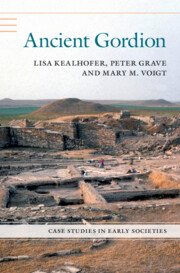23 results
Early identification of autism spectrum disorder in children with CHD attending a Cardiac Developmental Outcomes Program
-
- Journal:
- Cardiology in the Young / Volume 34 / Issue 3 / March 2024
- Published online by Cambridge University Press:
- 19 July 2023, pp. 483-488
-
- Article
- Export citation
References
-
- Book:
- Ancient Gordion
- Published online:
- 23 September 2022
- Print publication:
- 08 September 2022, pp 380-408
-
- Chapter
- Export citation
6 - Reconstituting Community in the Early Iron Age
-
- Book:
- Ancient Gordion
- Published online:
- 23 September 2022
- Print publication:
- 08 September 2022, pp 136-170
-
- Chapter
- Export citation
1 - Introduction
-
- Book:
- Ancient Gordion
- Published online:
- 23 September 2022
- Print publication:
- 08 September 2022, pp 1-11
-
- Chapter
- Export citation
2 - Inventing Identity
-
- Book:
- Ancient Gordion
- Published online:
- 23 September 2022
- Print publication:
- 08 September 2022, pp 12-28
-
- Chapter
- Export citation

Ancient Gordion
-
- Published online:
- 23 September 2022
- Print publication:
- 08 September 2022
3 - Contextualizing the Ceramic Assemblage
-
- Book:
- Ancient Gordion
- Published online:
- 23 September 2022
- Print publication:
- 08 September 2022, pp 29-54
-
- Chapter
- Export citation
9 - Identities in Flux
-
- Book:
- Ancient Gordion
- Published online:
- 23 September 2022
- Print publication:
- 08 September 2022, pp 301-354
-
- Chapter
- Export citation
4 - Identifying Gordion’s Groups
-
- Book:
- Ancient Gordion
- Published online:
- 23 September 2022
- Print publication:
- 08 September 2022, pp 55-85
-
- Chapter
- Export citation
Abbreviations
-
- Book:
- Ancient Gordion
- Published online:
- 23 September 2022
- Print publication:
- 08 September 2022, pp xii-xiv
-
- Chapter
- Export citation
5 - The Late Bronze Age Community at Gordion
-
- Book:
- Ancient Gordion
- Published online:
- 23 September 2022
- Print publication:
- 08 September 2022, pp 86-135
-
- Chapter
- Export citation
Acknowledgments
-
- Book:
- Ancient Gordion
- Published online:
- 23 September 2022
- Print publication:
- 08 September 2022, pp x-xi
-
- Chapter
- Export citation
8 - Enacting Power
-
- Book:
- Ancient Gordion
- Published online:
- 23 September 2022
- Print publication:
- 08 September 2022, pp 227-300
-
- Chapter
- Export citation
Appendix - Eski Çağ’da Gordion:
-
- Book:
- Ancient Gordion
- Published online:
- 23 September 2022
- Print publication:
- 08 September 2022, pp 373-379
-
- Chapter
- Export citation
Index
-
- Book:
- Ancient Gordion
- Published online:
- 23 September 2022
- Print publication:
- 08 September 2022, pp 409-422
-
- Chapter
- Export citation
Copyright page
-
- Book:
- Ancient Gordion
- Published online:
- 23 September 2022
- Print publication:
- 08 September 2022, pp vi-vi
-
- Chapter
- Export citation
10 - Conclusion
-
- Book:
- Ancient Gordion
- Published online:
- 23 September 2022
- Print publication:
- 08 September 2022, pp 355-372
-
- Chapter
- Export citation
Contents
-
- Book:
- Ancient Gordion
- Published online:
- 23 September 2022
- Print publication:
- 08 September 2022, pp vii-ix
-
- Chapter
- Export citation
7 - New Identities, New Communities
-
- Book:
- Ancient Gordion
- Published online:
- 23 September 2022
- Print publication:
- 08 September 2022, pp 171-226
-
- Chapter
- Export citation
Colonial Festivals and Loyalty - Colonial Loyalties: Celebrating the Spanish Monarchy in Eighteenth-Century Lima. By María Soledad Barbón. Notre Dame, Ind.: University of Notre Dame Press, 2019. Pp. 264. $55.00 cloth.
-
- Journal:
- The Americas / Volume 78 / Issue 1 / January 2021
- Published online by Cambridge University Press:
- 26 January 2021, pp. 159-161
- Print publication:
- January 2021
-
- Article
- Export citation



